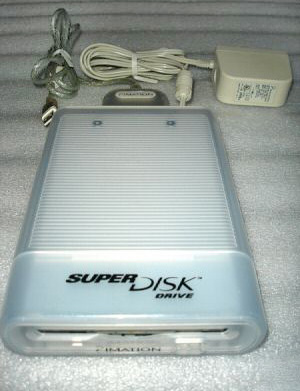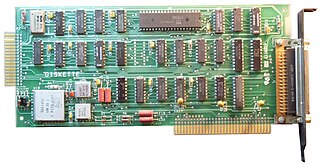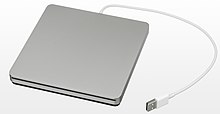
A floppy disk or floppy diskette is a type of disk storage composed of a thin and flexible disk of a magnetic storage medium in a square or nearly square plastic enclosure lined with a fabric that removes dust particles from the spinning disk. Floppy disks store digital data which can be read and written when the disk is inserted into a floppy disk drive (FDD) connected to or inside a computer or other device.

The Macintosh Plus computer is the third model in the Macintosh line, introduced on January 16, 1986, two years after the original Macintosh and a little more than a year after the Macintosh 512K, with a price tag of US$2,599. As an evolutionary improvement over the 512K, it shipped with 1 MB of RAM standard, expandable to 4 MB, and an external SCSI peripheral bus, among smaller improvements. Originally, the computer's case was the same beige color as the original Macintosh, Pantone 453; however, in 1987, the case color was changed to the long-lived, warm gray "Platinum" color. It is the earliest Macintosh model able to run System Software 5, System 6, and System 7, up to System 7.5.5, but not System 7.5.2.

The Power Macintosh G3 is an Obsolete series of personal computers designed, manufactured, and sold by Apple Computer from November 1997 to August 1999. It represented Apple's first step towards eliminating redundancy and complexity in the product line by replacing eight Power Macintosh models with three: Desktop and Mini Tower models for professional and home use, and an all-in-one model for education. The introduction of the Desktop and Mini Tower models coincided with Apple starting to sell build-to-order Macs directly from its web site in an online store, which was unusual for the time as Dell was the only major computer manufacturer doing this. Apple's move to build-to-order sales of the Power Macintosh G3 also coincided with the acquisition of Power Computing Corporation, which had been providing telephone sales of Macintosh clones for more than two years.

The SuperDisk LS-120 is a high-speed, high-capacity alternative to the 90 mm (3.5 in), 1.44 MB floppy disk. The SuperDisk hardware was created by 3M's storage products group Imation in 1997, with manufacturing chiefly by Matsushita.

The Zip drive is a removable floppy disk storage system that was announced by Iomega in 1994 and began shipping in March 1995. Considered medium-to-high-capacity at the time of its release, Zip disks were originally launched with capacities of 100 MB, then 250 MB, and finally 750 MB.
In computing, a removable media is a data storage media that is designed to be readily inserted and removed from a system. Most early removable media, such as floppy disks and optical discs, require a dedicated read/write device to be installed in the computer, while others, such as USB flash drives, are plug-and-play with all the hardware required to read them built into the device, so only need a driver software to be installed in order to communicate with the device. Some removable media readers/drives are integrated into the computer case, while others are standalone devices that need to be additionally installed or connected.

A Flash drive is a data storage device that includes flash memory with an integrated USB interface. A typical USB drive is removable, rewritable, and smaller than an optical disc, and usually weighs less than 30 g (1 oz). Since first offered for sale in late 2000, the storage capacities of USB drives range from 8 to 256 gigabytes (GB), 512 GB and 1 terabyte (TB). As of 2023, 2 TB flash drives were the largest currently in production. Some allow up to 100,000 write/erase cycles, depending on the exact type of memory chip used, and are thought to physically last between 10 and 100 years under normal circumstances.

The Macintosh 512K is a personal computer that was designed, manufactured and sold by Apple Computer from September 1984 to April 1986. It is the first update to the original Macintosh 128K. It was virtually identical to the previous Macintosh, differing primarily in the amount of built-in random-access memory. The increased memory turned the Macintosh into a more business-capable computer and gained the ability to run more software. It is the earliest Macintosh model that can be used as an AppleShare server and, with a bridge Mac, communicate with modern devices.

The PowerBook G3 is a series of laptop Macintosh personal computers designed, manufactured, and sold by Apple Computer from 1997 to 2001. It was the first laptop to use the PowerPC G3 (PPC740/750) series of microprocessors, and was marketed as the fastest laptop in the world for its entire production run. The PowerBook G3 was succeeded by the PowerBook G4.

A disk enclosure is a specialized casing designed to hold and power hard disk drives or solid state drives while providing a mechanism to allow them to communicate to one or more separate computers.
In computing, external storage refers to non-volatile (secondary) data storage outside a computer's own internal hardware, and thus can be readily disconnected and accessed elsewhere. Such storage devices may refer to removable media, compact flash drives, portable storage devices, or network-attached storage. Web-based cloud storage is the latest technology for external storage.

A floppy-disk controller (FDC) is a hardware component that directs and controls reading from and writing to a computer's floppy disk drive (FDD). It has evolved from a discrete set of components on one or more circuit boards to a special-purpose integrated circuit or a component thereof. An FDC is responsible for reading data presented from the host computer and converting it to the drive's on-disk format using one of a number of encoding schemes, like FM encoding or MFM encoding, and reading those formats and returning it to its original binary values.
IMG, in computing, refers to binary files with the .img filename extension that store raw disk images of floppy disks, hard drives, and optical discs or a bitmap image – .img.

The PowerBook 3400c is a laptop computer in the PowerBook line manufactured by Apple Computer from February to November 1997. It was briefly the fastest laptop in the world. Using the PowerPC 603e processor running at speeds of up to 240 MHz, this PowerBook was the first to feature a PCI architecture, EDO memory, and a 64-bit wide, 40 MHz internal bus. It was also the first PowerBook to feature a PC card slot capable of being used as a zoomed video port. Like all Apple laptops since the PowerBook 500 series, it featured a built-in trackpad as the pointing device.

The Disk II Floppy Disk Subsystem, often rendered as Disk ][, is a 5 +1⁄4-inch floppy disk drive designed by Steve Wozniak at the recommendation of Mike Markkula, and manufactured by Apple Computer, Inc. It went on sale in June 1978 at a retail price of US$495 for pre-order; it was later sold for $595 including the controller card and cable. The Disk II was designed specifically for use with the Apple II personal computer family to replace the slower cassette tape storage.

A live USB is a portable USB-attached external data storage device containing a full operating system that can be booted from. The term is reminiscent of USB flash drives but may encompass an external hard disk drive or solid-state drive, though they may be referred to as "live HDD" and "live SSD" respectively. They are the evolutionary next step after live CDs, but with the added benefit of writable storage, allowing customizations to the booted operating system. Live USBs can be used in embedded systems for system administration, data recovery, or test driving, and can persistently save settings and install software packages on the USB device.

Target Disk Mode is a boot mode unique to Macintosh computers.

The Power Macintosh 5500 is a personal computer designed, manufactured, and sold by Apple Computer from February 1997 to March 1998. Like the Power Macintosh 5260 and 5400 that preceded it, the 5500 is an all-in-one design, built around a PowerPC 603ev processor operating at 225, 250 or 275 megahertz (MHz).

The Macintosh External Disk Drive is the original model in a series of external 3+1⁄2-inch floppy disk drives manufactured and sold by Apple Computer exclusively for the Macintosh series of computers introduced in January 1984. Later, Apple would unify their external drives to work cross-platform between the Macintosh and Apple II product lines, dropping the name "Macintosh" from the drives. Though Apple had been producing external floppy disk drives prior to 1984, they were exclusively developed for the Apple II, III and Lisa computers using the industry standard 5+1⁄4-inch flexible disk format. The Macintosh external drives were the first to widely introduce Sony's new 3+1⁄2-inch rigid disk standard commercially and throughout their product line. Apple produced only one external 3+1⁄2-inch drive exclusively for use with the Apple II series called the Apple UniDisk 3.5.

The floppy disk is a data storage and transfer medium that was ubiquitous from the mid-1970s well into the 2000s. Besides the 3½-inch and 5¼-inch formats used in IBM PC compatible systems, or the 8-inch format that preceded them, many proprietary floppy disk formats were developed, either using a different disk design or special layout and encoding methods for the data held on the disk.





















